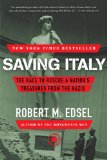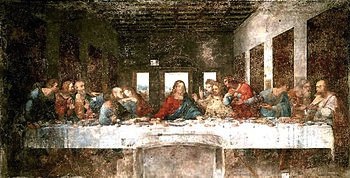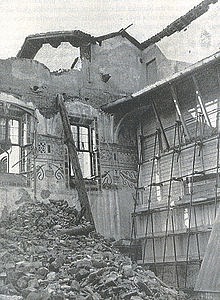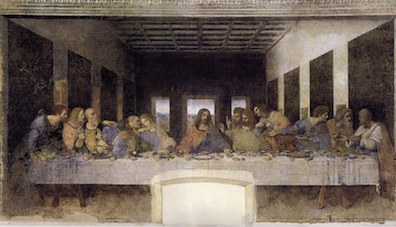Summary | Excerpt | Reviews | Beyond the Book | Read-Alikes | Genres & Themes | Author Bio

The Race to Rescue a Nation's Treasures from the Nazis
by Robert M. EdselThis article relates to Saving Italy
The Last Supper, completed by Leonardo da Vinci in 1498, is one of Western civilization's great cultural touchstones. Housed in the refectory of the Dominican Convent of Santa Maria delle Grazie in Milan, this late 15th century work was commissioned as part of planned renovations to the convent and church buildings by da Vinci's patron, Ludovico Sforza, the Duke of Milan. The painting, which measures about 15 by 39 feet, depicts the desciple's immediate reactions following Christ's announcement that one of them will betray him before dawn. In spite of the emotional chaos that rings throughout the scene, the composition is ordered and serene. Christ's head is at the center of the composition, and the angling of the walls within the picture lead back to windows that display a view of hills and sky which frame the figure of Christ.
 The traditional method for painting murals was the fresco technique, in which water based paint is applied to fresh plaster, so that when the plaster dries the painting becomes an integral part of the wall and thus can last for centuries. Da Vinci chose not to use this technique, presumably because he wanted to be able to spend more time on the painting than the fresco method allows, and instead painted The Last Supper on to a dry wall. As a result, the mural began to flake and deteriorate just a few years after it was finished. By 1556, artist and art biographer Giorgio Vasari described the painting as "ruined". Over time, various restoration efforts were undertaken, but the attempts were often misguided, including the hanging of a curtain in 1768 which was meant to protect the mural; instead, it trapped moisture against the painted surface further contributing to the deterioration of the mural. The most recent stabilization efforts have often had to remove the work of earlier restorers. In addition to the normal ravages of time, the refectory was used at various times as a prison, and in 1796 it was used as an armory by French anti-clerical troops who deliberately damaged the painting.
The traditional method for painting murals was the fresco technique, in which water based paint is applied to fresh plaster, so that when the plaster dries the painting becomes an integral part of the wall and thus can last for centuries. Da Vinci chose not to use this technique, presumably because he wanted to be able to spend more time on the painting than the fresco method allows, and instead painted The Last Supper on to a dry wall. As a result, the mural began to flake and deteriorate just a few years after it was finished. By 1556, artist and art biographer Giorgio Vasari described the painting as "ruined". Over time, various restoration efforts were undertaken, but the attempts were often misguided, including the hanging of a curtain in 1768 which was meant to protect the mural; instead, it trapped moisture against the painted surface further contributing to the deterioration of the mural. The most recent stabilization efforts have often had to remove the work of earlier restorers. In addition to the normal ravages of time, the refectory was used at various times as a prison, and in 1796 it was used as an armory by French anti-clerical troops who deliberately damaged the painting.
 In 1943, an Allied bomb struck the building. The Last Supper had been sandbagged and reinforced so that bomb splinters didn't strike it, but the explosive vibrations may have done damage. It was one of the Italian art treasures preserved by the Monuments Men, a special detachment of Allied soldiers whose job it was to protect the cultural treasures of Europe, particularly Italy, from both the Nazis and the ravages of war. (See review.) The Monuments Men worked to preserve the mural in the days after Milan was taken by the Allies.
In 1943, an Allied bomb struck the building. The Last Supper had been sandbagged and reinforced so that bomb splinters didn't strike it, but the explosive vibrations may have done damage. It was one of the Italian art treasures preserved by the Monuments Men, a special detachment of Allied soldiers whose job it was to protect the cultural treasures of Europe, particularly Italy, from both the Nazis and the ravages of war. (See review.) The Monuments Men worked to preserve the mural in the days after Milan was taken by the Allies.
 In 1978, Pinin Brambilla Barcilon began a twenty year restoration of The Last Supper, with the aim of permanently stabilizing the painting; and cleaning up damage caused by dirt, pollution and earlier restoration efforts. When the work was complete in 1999, it was redisplayed. The restoration, though popularly acclaimed, has generated its share of controversy due to the changes in facial shapes and colors.
In 1978, Pinin Brambilla Barcilon began a twenty year restoration of The Last Supper, with the aim of permanently stabilizing the painting; and cleaning up damage caused by dirt, pollution and earlier restoration efforts. When the work was complete in 1999, it was redisplayed. The restoration, though popularly acclaimed, has generated its share of controversy due to the changes in facial shapes and colors.
Filed under Music and the Arts
![]() This "beyond the book article" relates to Saving Italy. It originally ran in June 2013 and has been updated for the
February 2014 paperback edition.
Go to magazine.
This "beyond the book article" relates to Saving Italy. It originally ran in June 2013 and has been updated for the
February 2014 paperback edition.
Go to magazine.






Your guide toexceptional books
BookBrowse seeks out and recommends the best in contemporary fiction and nonfiction—books that not only engage and entertain but also deepen our understanding of ourselves and the world around us.